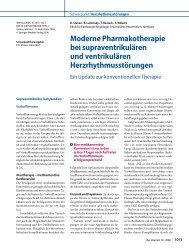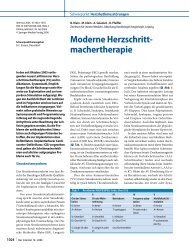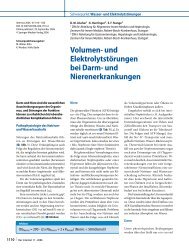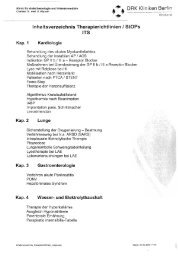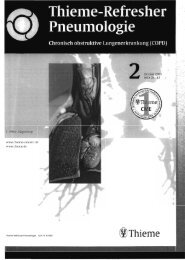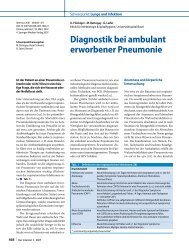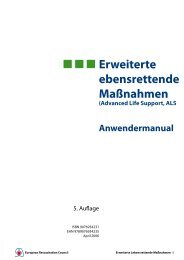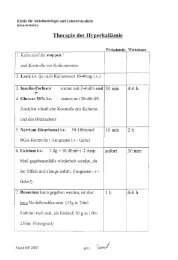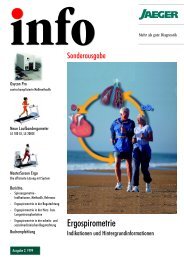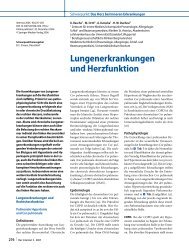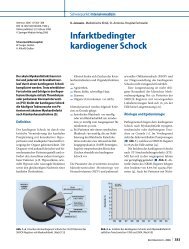Diagnostik der pulmonalen Tuberkulose beim ... - Erkan Arslan
Diagnostik der pulmonalen Tuberkulose beim ... - Erkan Arslan
Diagnostik der pulmonalen Tuberkulose beim ... - Erkan Arslan
Erfolgreiche ePaper selbst erstellen
Machen Sie aus Ihren PDF Publikationen ein blätterbares Flipbook mit unserer einzigartigen Google optimierten e-Paper Software.
Verlaufskontrolle<br />
Zur Verlaufskontrolle ist eine monatliche<br />
Sputumuntersuchung (Direktpräparat<br />
und Kultur) empfohlen, bis 2 konsekutive<br />
Sputa kulturell negativ sind [3].<br />
E Die PCR-<strong>Diagnostik</strong> auf M.<br />
tuberculosis-Komplex eignet sich<br />
nicht für Verlaufsuntersuchungen.<br />
Sind Direktpräparat und Kultur nach<br />
2 Monaten noch positiv, so hat dies die<br />
Konsequenz einer Verlängerung <strong>der</strong> Therapiedauer<br />
von 6 auf 9 Monate. Ist das Direktpräparat<br />
nach dem 5. Monat noch positiv,<br />
wird gemäß WHO von einem Therapieversagen<br />
ausgegangen und ein Wechsel<br />
<strong>der</strong> Behandlungsstrategie nötig.<br />
Fazit für die Praxis<br />
Die TB ist weltweit sehr häufig, zunehmend<br />
mit resistenten Keimen. Migranten<br />
aus Hochendemiegebieten haben<br />
das Risiko ihres Herkunftslandes. Diagnostisch<br />
wegweisend ist das Röntgenbild,<br />
jedoch muss bei Immunsupprimierten<br />
bei atypischer Präsentation o<strong>der</strong> fehlendem<br />
Infiltrat an eine TB gedacht werden.<br />
3 sequenziell abgenommene Sputa<br />
sind empfohlen (Mikroskopie und Kultur,<br />
evtl. PCR auf M. tuberculosis-Komplex).<br />
Goldstandard bleibt die Kultur, die<br />
für die Sensibilitätstestung auf die Erstlinienmedikamente<br />
nötig ist. Eine <strong>Diagnostik</strong><br />
für eine latente TB soll nur bei<br />
Personen mit erhöhtem TB-Risiko, erhöhtem<br />
beruflichen Risiko und Kontaktpersonen<br />
mit offener TB vorgenommen<br />
werden und sollte im Falle eines positiven<br />
Befundes nach Ausschluss einer aktiven<br />
Erkrankung eine präventive Therapie<br />
zur Folge haben. Tuberkulintest und<br />
neu entwickelte Bluttests basierend auf<br />
einem Nachweis von Interferon-g nach<br />
Ex-vivo-Exposition mit mykobakteriellen<br />
Antigenen sind nach heutigem Erkenntnisstand<br />
im wesentlichen äquivalent mit<br />
gewissen Vorteilen für die neueren Bluttests.<br />
496 | Der Internist 5 · 2007<br />
Schwerpunkt: Lunge und Infektion<br />
Korrespondieren<strong>der</strong> Autor<br />
Dr. G. Laifer<br />
Klinik für Infektiologie, Universitätsspital Basel<br />
Petersgraben 4, CH-4031 Basel<br />
Laiferg@uhbs.ch<br />
Interessenkonflikt. Es besteht kein Interessenkonflikt.<br />
Der korrespondierende Autor versichert, dass keine<br />
Verbindungen mit einer Firma, <strong>der</strong>en Produkt in<br />
dem Artikel genannt ist, o<strong>der</strong> einer Firma, die ein Konkurrenzprodukt<br />
vertreibt, bestehen. Die Präsentation<br />
des Themas ist unabhängig und die Darstellung <strong>der</strong> Inhalte<br />
produktneutral.<br />
Literatur<br />
1. American Thoracic Society (2000) Targeted tuberculin<br />
testing and treatment of latent tuberculosis<br />
infection. MMWR 49: 1–51<br />
2. Aziz MA, Wright A, Laszlo A et al. (2006) Epidemiology<br />
of antituberculosis drug resistance (the Global<br />
Project on Anti-tuberculosis Drug Resistance<br />
Surveillance): an updated analysis. Lancet 368:<br />
2142–2154<br />
3. Centers for Disease Control and Prevention (2003)<br />
Treatment of tuberculosis. MMWR Recomm Rep<br />
52:1–77<br />
4. Corbett EL, Watt CJ, Walker N et al. (2003) The growing<br />
burden of tuberculosis: global trends and interactions<br />
with the HIV epidemic. Arch Intern Med<br />
163: 1009–1021<br />
5. Dewan PK, Grinsdale K, Kawamura LM (2007) Low<br />
sensitivity of a whole-blood interferon-g release<br />
assay for detection of active tuberculosis. Clin Infect<br />
Dis 44: 69–73<br />
6. Ewer K, Deeks J, Alvarez L et al. (2003) Comparison<br />
of T-cell-based assay with tuberculin skin test<br />
for diagnosis of Mycobacterium tuberculosis infection<br />
in a school tuberculosis outbreak. Lancet 361:<br />
1168–1173<br />
7. Ferrara G, Losi M, D’Amico R et al. (2006) Use in<br />
routine clinical practice of two commercial blood<br />
tests for diagnosis of infection with Mycobacterium<br />
tuberculosis: a prospective study. Lancet 367:<br />
1328–1334<br />
8. Frieden TR, Sterling TR, Munsiff SS et al. (2003) Tuberculosis.<br />
Lancet 362: 887–899<br />
9. Kommission „Interferon-Gamma für die <strong>Diagnostik</strong><br />
<strong>der</strong> <strong>Tuberkulose</strong>-Infektion“ <strong>der</strong> Lungenliga<br />
Schweiz (2005) Erkennung <strong>der</strong> <strong>Tuberkulose</strong>infektion<br />
mittels Bluttest (Interferon-gamma). Bundesamt<br />
für Gesundheit Bulletin 45: 822–823<br />
10. Laifer G, Widmer AF, Frei R et al. (2004) Polymerase<br />
chain reaction for Mycobacterium tuberculosis:<br />
impact on clinical management of refugees with<br />
pulmonary infiltrates. Chest 125: 981–986<br />
11. Laifer G, Widmer AF, Simcock M et al. (2007) Pulmonary<br />
tuberculosis in a low incidence country:<br />
new immigrants, foreign-born residents and native<br />
residents. Am J Med (in press)<br />
12. Lee JY, Choi HJ, Park IN, et al. (2006) Comparison of<br />
two commercial interferon-gamma assays for diagnosing<br />
Mycobacterium tuberculosis infection.<br />
Eur Resp J 28: 24–30<br />
13. Morbidity and Mortality Weekly Report (2006).<br />
Emergence of Mycobacterium tuberculosis with<br />
extensive resistance to second-line drugs worldwide<br />
2000–2004. 55: 301–305<br />
14. Moore DA, Evans CA, Gilman RH et al. (2006)<br />
Microscopic-observation drug-susceptibility assay<br />
for the diagnosis of tuberculosis. N Engl J Med 355:<br />
1539–1550<br />
15. National Collaborating Centre for Chronic Conditions<br />
(2006) Tuberculosis: clinical diagnosis and<br />
management of tuberculosis, and measures for<br />
its prevention and control. Royal College of Physicians,<br />
London<br />
16. Pai M, Menzies D (2007) Interferon-g release assays:<br />
what is their role in the diagnosis of active tuberculosis?<br />
Clin Infect Dis 44: 74–77<br />
17. Pai M, Riley LW, Colford JM Jr (2004) Interferongamma<br />
assays in the immunodiagnosis of tuberculosis:<br />
a systematic review. Lancet Infect Dis 4:<br />
761–776<br />
18. Poulsen A (1957) Some clinical features of tuberculosis.<br />
Acta Tuberc Scand 33: 37–92<br />
19. Small PM, Fujiwara PI (2001) Management of tuberculosis<br />
in the United States. N Engl J Med 345:<br />
189–200<br />
20. Telenti A, Imboden P, Marchesi F et al. (1993)<br />
Detection of rifampicin-resistance mutations in<br />
Mycobacterium tuberculosis. Lancet 341: 647–650<br />
21. Tissot F, Zanetti G, Francioli P et al. (2005) Influence<br />
of bacille Calmette-Guerin vaccination on size of<br />
tuberculin skin test reaction: to what size? Clin Infect<br />
Dis 40: 211–217<br />
22. Vidal R, Casabona N, Juan A et al. (1996) Incidence<br />
and significance of acid-fast bacilli in sputum<br />
smears at the end of antituberculous treatment.<br />
Chest 109: 1562–1565<br />
23. Zhang Y, Vilchèze C, Jacobs WR et al. (2005) Mechanisms<br />
of drug resistance in Mycobacterium tuberculosis.<br />
In: Cole ST, Eisenach KD, McMurray DN<br />
et al. (Eds) Tuberculosis and the tubercle bacillus.<br />
ASM Press, Washington DC, p 115–140



